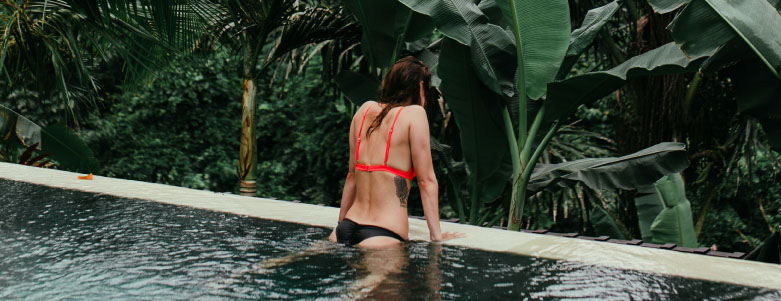Caring For Your Pool After A Heavy Rainfall
It’s the middle of summer and there's a storm. After the storm, you cleaned the debris off the top of your pool, and it looks clean enough! But is that all you need to do? No! Pool cleaning after a rainstorm is an entire process, and it can help preserve the health of your pool for years to come.

Rainfall might not only cause loose branches and leaves to drop into your pool, but it could also cause overflow and will most certainly contaminate the water. These contaminants pave the way for algae growth and many other undesirables in your pristine pool water. There are many things to consider when you clean your pool after heavy rains and the order in which things are to be done matters! Here’s what you need to do after a downpour to get your swimming pool back to its swim-ready condition.
Check the water levels
After heavy rains, your pool water level will almost always be beyond what it should be around the halfway level of the skimmer’s opening. You need to get the water level to mid-skimmer level. For that, you’ll need to hook up your pool pump and set it to ‘waste’ or ‘backwash’. Keep monitoring the water level in the pool as it drains out. Make sure it doesn’t drop below the opening of the skimmer. That will make air enter your pump, and the motor will burn.
If you wish to clean while the water drains, you can connect your pool vacuum to the skimmer. That will ensure your pool floor gets vacuumed as the water exits the pool.
Check out another one of our posts on how to care for your pool after rainfall!
Clean the debris
Once you’re done correcting the water level, you will want to clean out your skimmer and pump baskets. Dirt like twigs, leaves, and bugs might be stuck in there. After cleaning the baskets, turn on your pump and keep it on ‘filter’. You can also keep your pump running even when it is raining. That will decrease some of your work after-storm pool cleaning work. Avoid this if the storm is accompanied by thunder.
Next, manually skim the surface and remove any floating debris that you can see. If you do not remove objects floating at the surface right now, they will gradually sink to the bottom. If you don’t plan on vacuuming, then that’s where they’ll stay till thorough pool cleaning is done. It will also mess with your pool water chemistry by creating unwanted changes in the chlorine and pH levels. These rotting matters can also be a reason for algal growth.
(Here’s what rainfall does to your pool!)
After that, you’ll want to pick up your scrubber and scrub the walls and stairs of your pool well. Chances are, many contaminants are sitting there, and they’ll turn your clear water green and murky at any given opportunity. Fibreglass pools are any day easier to clean compared to concrete pools, owing to their smooth gel-coated finish. They have smoother surfaces and are devoid of joints. There are close to no nooks and crannies for contaminants to hide in. Then, hook up your vacuum to your skimmer and vacuum the floor of the pool. Work your way across the entire length of the pool, to be on the safer side.
If you do not have a vacuum, you can push the sunken debris near the opening of your main drain. The working pump should suck up the contaminants and send them to the filter.

Rebalancing the pool water
Now that you are cleaning out all the dirt, muck, and twigs from your pool, your water is looking crystal clear. But wait! Acidic rainwater, runoff from your roof, and patio, and all the contaminants you cleaned out have messed up your pool’s pH levels. Water that is too acidic could start to eat up your pool surface, metal pool stairs, equipment, and heater, which could end up in repairs costing lots of money.
Now is the time to test your water’s pH levels, it shouldn’t be too acidic or alkaline. Chlorine is also unable to do a good job in highly acidic or alkaline environments. Ideally, you should super chlorinate your water, to help recharge chlorine levels and then put the required chemicals to balance out your pH. pH levels are easy to check with DIY pool pH testing kits.
If you do not know how to check the alkalinity and chlorine levels at home, you could take them to professionals. They can also recommend chemicals to bring the levels back to normal.
You can also shock your pool while it is raining to give the chlorine more time to take effect. However, this treatment won’t be as effective as shocking the pool after the rains as contaminants will continue pouring in.
Once this is all done, you might want to run your pump for a long while, just to make sure all the debris and contaminants are out. This will make your filter dirty, so clean it once the job is done.

Post cleaning
Before the next predicted showers, you could shock your pool beforehand, to give it a head start on combating the contaminants. You might also want to use a pool cover, to minimise the amount of cleaning you’ll have to do after the rains. It should keep most of the debris, run-off, and rainwater out.
Rains also give you a chance to check your pool’s drainage system. If it’s not working correctly, you will know once you start running the pump. Heavy rainstorms really highlight any problems in the drainage system that might exist, and you can then fix them accordingly.
Conclusion
After a storm, pool cleanup might appear to be a lengthy process, but if you do it right, it does not take much time at all. Also, when you see your clear, sparkling pool water, it will give you a sense of accomplishment. It lengthens your pool’s lifespan by years too, which makes all the work worth it. A few steps taken beforehand can reduce the workload post-showers.
The type of pool you have at home will also decide how much effort you need to put in for an after-rain pool cleaning. Smaller, simpler, pools with smoother surfaces are easier to brush and can be cleaned quickly. Larger pools with irregular shapes might take more time and effort when it comes to pool cleaning. At the end of the day, if you feel like it is too much work, you can always call the professionals. The point here is to always ensure that your pool gets the proper treatment it deserves after every downpour to maintain your pool’s health.

